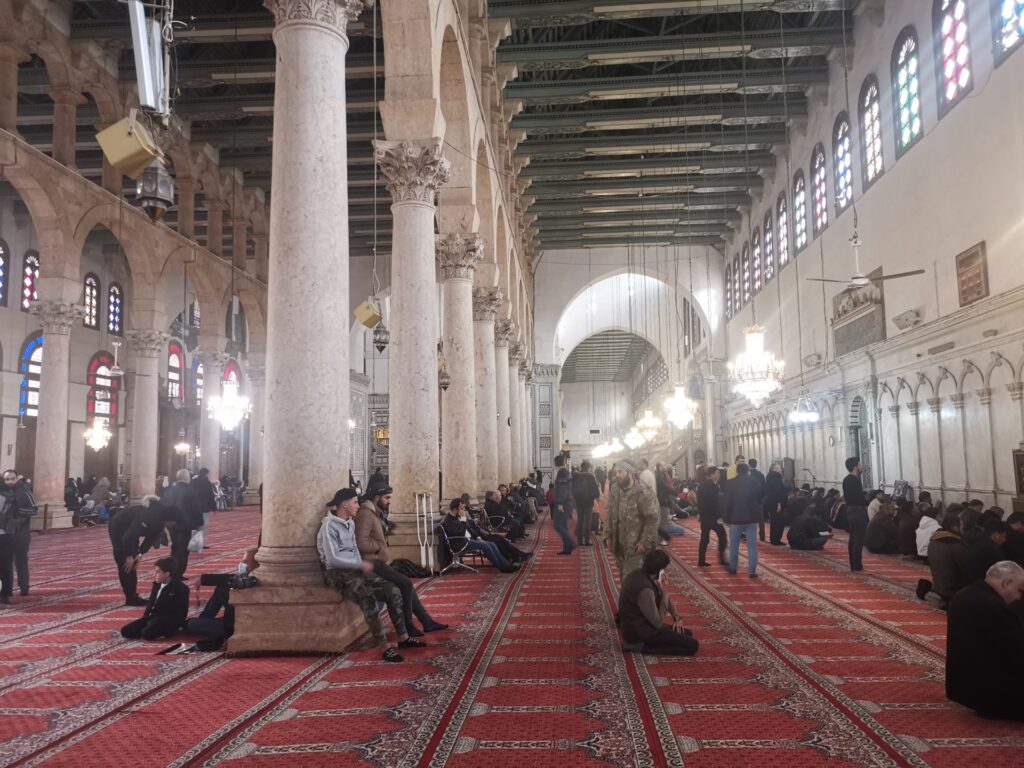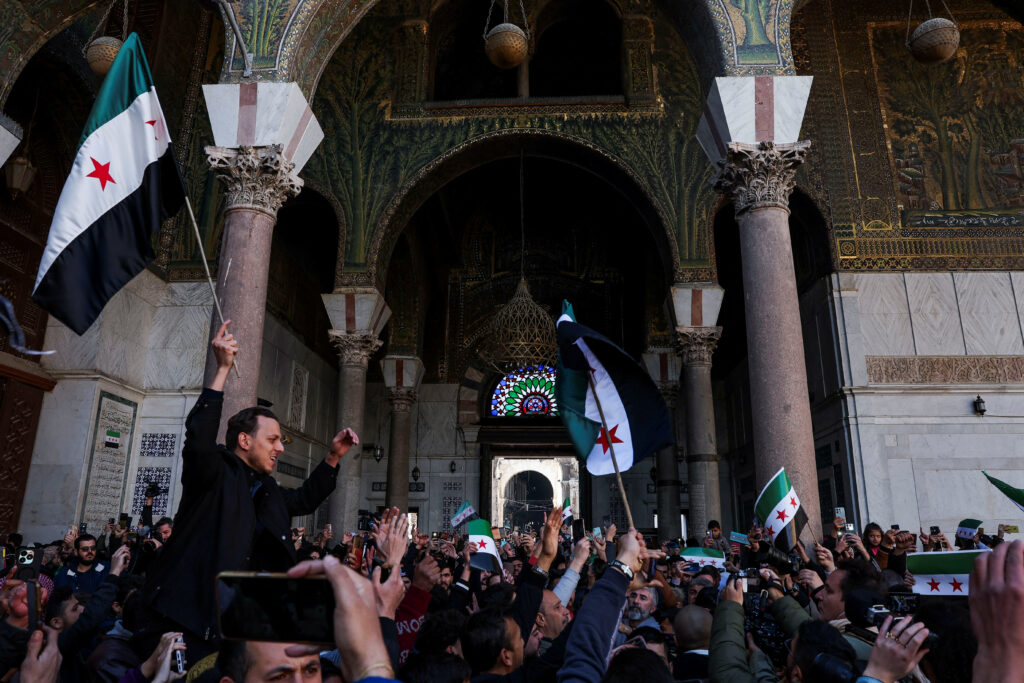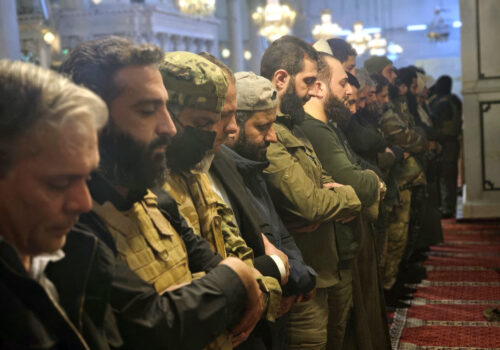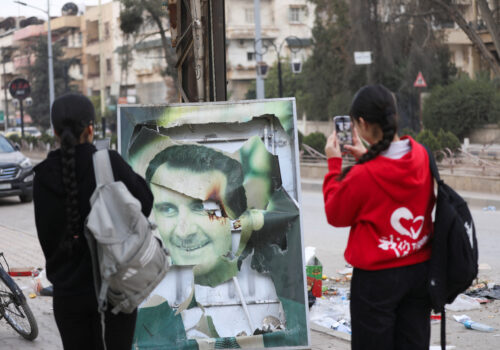DAMASCUS—After more than a decade of conflict, Syrian rebels, led by Hayat Tahrir al-Sham (HTS), have successfully overthrown the Assad regime. The rapid and unanticipated advance of the rebels raises numerous questions about the future of Syria. Many people around the world, especially Syrians, are speculating about what lies ahead for their country and how the international community—particularly the United States—will respond. While in Damascus, I witnessed firsthand the early atmosphere in Syria’s capital.
Upon arriving in Damascus on December 10, two days after the collapse of the Assad regime, I immediately went to the famous Umayyad Square, where I witnessed the joy and celebrations among many Syrians. The atmosphere was vibrant, marked by fireworks, sporadic gunfire, and massive crowds. Interestingly, I soon found myself speaking with around twenty young Syrians in Turkish. They had all lived in Turkey but had returned to Syria some time ago, rushing from the Turkey-protected areas in northern Syria to the capital. Among them were both civilians and individuals in military uniforms.
Several hours later, the city calmed down. The curfew and the darkness of the night transformed the city from a joyous festival into a silent ambiguity—a mood that indicates Syria’s hopeful but uncertain future.
The next day, the streets of Damascus were busy and crowded. People rushed through the streets as their daily lives continued. The Umayyad Mosque was filled with visiting Syrians. However, the Syrian rebels captured the most attention from the visitors. The rebels were busy taking pictures and praying alongside the civilians. This excitement wasn’t limited to the mosque; throughout the city, civilians cheered for the rebels.

But the relative optimism in the city is accompanied by suspicion. Just as the world is closely monitoring the situation in Syria, Syrians are also pondering whether the positive and relatively inclusive messages from the Syrian rebels, particularly those of HTS’s leader, Ahmad al-Shara (formerly known by his nom de guerre, Abu Mohammed al-Jolani), will be borne out in the way they govern the country.
Syrian minority groups, including Christians, Shiites, and Alawites in Damascus, are hopeful that the rebels have learned from their past mistakes and are sincere in their approach. However, many remain concerned about potential acts of revenge against members of minority groups who are perceived as having been loyal to the Assad regime. Efforts are underway to reassure them, but one thing is clear: the military and security personnel in Damascus are insufficient. Due to the focus on securing the Assad regime’s former strongholds in Tartus and Latakia, as well as a lack of manpower, many streets and neighborhoods remain unguarded. This reality gives minority groups ample reason to be fearful.
Given the new political reality in Syria and the uncertainty surrounding it, many individuals, including known personalities who have collaborated with the Assad regime, express disdain for it publicly in an effort to demonstrate their loyalty to the new authorities in Damascus. For example, many members of the hotel staff, where I am writing this article, loudly criticize Assad whenever they encounter rebel personnel or commanders. Although the hotel owner, rumored to be a close associate of the regime, has fled to Lebanon, most of the staff members continue to work here.
As the less organized reconciled rebels from southern Syria and sporadic uprisings reached Damascus, many state institutions and properties belonging to the Assad family were devastated. I was informed that order was restored with the arrival of HTS and the Syrian National Army (SNA), a rebel militia backed by Turkey.
Many in Damascus view the establishment of the transitional government as the first test that will determine the city’s future direction. Some believe that the transitional government will only handle managerial tasks and will be temporary until March 2025, arguing that the period following this date will be more crucial.
The power struggle ahead
The key question is how much power HTS will share with other Syrian rebel groups and the broader Syrian population. Observing the situation in Idlib, some critics worry that HTS may ultimately seek to establish its dominance. They point out that since Shara has gained the status akin to that of a national hero, he may be less inclined to agree to power-sharing arrangements.
Others argue that Shara must share power, even if he is resistant to the idea. They contend that without the SNA and the reconciled rebels from the south, HTS lacks the manpower necessary to control Syria and ensure security. Additionally, they claim that the designation of HTS as a terrorist organization by the United Nations, the United States, Turkey, and others creates an opportunity to promote a more inclusive transitional government, incorporating regime technocrats and representatives from both the civilian and armed Syrian opposition.
A recent meeting between the military leaders of HTS, the SNA, and reconciled rebels could signal exactly this. There are strong rumors that HTS, SNA, and the reconciled rebels are in discussions about the possibility of disbanding their individual factions to form a united military structure.
Skeptics and optimists alike agree that foreign states could play a crucial role in facilitating a smooth and inclusive transition in Syria. Many point to Turkey’s involvement, while a few highlight Qatar’s contributions as well. In contrast, Washington is viewed as pursuing a narrow interest without a clear agenda. The US partnership with the Syrian Democratic Forces (SDF), an entity dominated by the Kurdish People’s Defense Units (YPG) to establish an autonomous region in Syria, is perceived in Damascus as a limited agenda that lacks sustainability. The United States has partnered with the SDF to fight the Islamic State of Iraq and al-Sham (ISIS). Contacts I have spoken to suggest that the days of the SDF may be numbered due to the overwhelming demographic strength of Arabs in SDF-held areas who are likely to oppose governance by Kurdish forces; the withdrawal of Russian troops, which had been protecting the SDF against Turkish forces; and offensives that the SNA, backed by Turkish drone strikes, has launched against SDF positions since Assad’s fall. Also, HTS officials I have spoken to clearly state that they won’t accept the status quo in northeastern Syria.
A roadmap for Washington
Looking from Damascus and with a good understanding of Ankara, I recommend that the United States broaden its focus in Syria beyond just the campaign against ISIS. Given the new realities in Syria and in anticipation of the incoming Trump administration, the United States should promote a more inclusive transitional period and collaborate with its NATO ally. A dispute between Ankara and Washington over the SDF is likely to be unproductive.
Washington should collaborate with Turkey and encourage non-YPG elements of the SDF to switch sides to the new authority in Damascus. In exchange, the United States could secure the interests of Kurds in the Kurdish areas by introducing the Kurdish National Council (KNC). The KNC is part of the Syrian opposition, is closely aligned with Iraqi Kurdistan, has good relations with Turkey, and represents the majority of Syrian Kurds. This cooperation can facilitate a safe US withdrawal from Syria in exchange for security guarantees regarding ISIS prisons in northeastern Syria, which are currently guarded by the SDF. An organized handover to prevent a mass escape will be the first step. Still, more importantly, with a new government established in Damascus, ISIS prisoners and their families could be properly prosecuted, something that the SDF couldn’t manage due to legislative obstacles.
Additionally, Washington should coordinate its approach to Syria with Ankara. US Secretary of State Antony Blinken’s visit to Ankara was a step in the right direction. However, judging by how bland the statements were from both sides after the meetings, it looks unlikely that there was agreement. To reach a solid deal, the United States must abandon the limited SDF project for a wider perspective toward all of Syria. While Turkey has become the most influential foreign actor in Syria, the United States still maintains significant leverage over the international legitimacy of the new Syrian government and funding for the country’s reconstruction. Combined Turkish and US influence can help guide Shara toward a realistic path that aligns with the best interests of the Syrian people.
Ömer Özkizilcik is a nonresident fellow for the Syria Project in the Atlantic Council’s Middle East Programs.
Further reading
Tue, Dec 10, 2024
A blueprint for bringing about a new Syria
New Atlanticist By Kirsten Fontenrose
For a reconstruction strategy in Syria to be effective, all parties must adopt a unified approach that is clear-eyed about the country’s new leaders.
Mon, Dec 9, 2024
Dispatch from Doha: Assad’s fall, Iran’s weakness, and the impact of unintended consequences
New Atlanticist By Jonathan Panikoff
In just six months, Iran has slid from a position of strength to perhaps the weakest it has been since 1979.
Sun, Dec 8, 2024
Assad has fallen. Now what?
Fast Thinking By
The power shift in Syria will reverberate across the Middle East and the world. Our experts explain what's next.
Image: People react after the first Friday prayers at the Umayyad Mosque, after fighters of the ruling Syrian body ousted Syria's Bashar al-Assad, in the Damascus old city, Syria, December 13, 2024. REUTERS/Amr Abdallah Dalsh.



